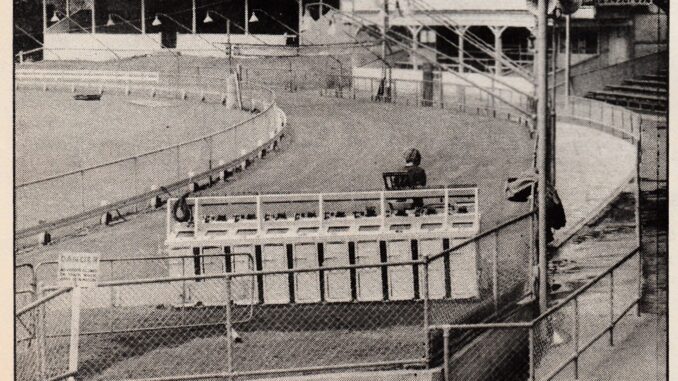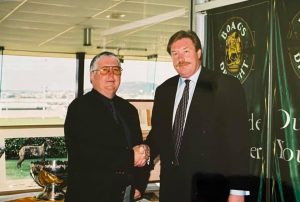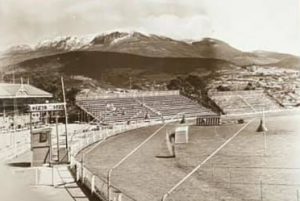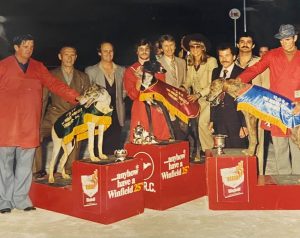
Hobart celebrates 90 years of greyhound racing
15 / 10 / 2025 Article by: Brennan Ryan
In Brief
- Hobart greyhounds celebrating 90 years of racing in Tasmania.
- Historian Greg Fahey reflects on the legacy of the nine decades.
- Greg talks about the Hobart Thousand, administrators and callers.
The Hobart Greyhound Racing Club celebrates 90 years of racing in southern Tasmania this Thursday night.
While the venues have changed over the past nine decades, the traditions of greyhound racing have remained the same.

Tasmanian historian Greg Fahey with former Labor Tasmanian Premier and Racing Minister Paul Lennon.
The club, founded in November 1933, held its first race day on 30 January, 1935, at the TCA Ground, the historic home of greyhound racing, under the name Hobart Speed Coursing Club, where the Hobart Cup (now known as the Hobart Thousand) was first introduced.
After the Speed Coursing Club was dissolved, the Hobart Greyhound Racing Club was established on 30 September, 1935. The club held its first race meeting on 20 October, 1935, under the leadership of Arthur Morgan, known as “the godfather of greyhound racing”.
Tasmanian greyhound historian Greg Fahey highlights just two key aspects that stand out in Hobart’s proud history.
“There are two absolute standouts: one is Arthur Morgan, and the other is the now Group 1 Hobart Thousand,” Greg Fahey said.
“Arthur Morgan was the godfather of greyhound racing in Tasmania, and he truly was. There would have been no greyhound racing or certainly never get off the ground the way it did, except for him. He drove it fearlessly and brought good people on board.
“Morgan ran things with an iron fist, which unfortunately you can’t do these days. He just didn’t want Hobart to be a successful club; Arthur wanted the Hobart greyhound club to be the best club in Australia, and to be the best club, you need the best race.”

TCA ground was the original home for Hobart Greyhound Racing in Tasmania.
Arthur Morgan served as the Secretary Manager for over three decades, stepping down on 2 October, 1967, and passing the reins to another iconic figure, Peter Wright. Morgan passed away years later, leaving behind a legacy for which racing remains deeply indebted.
Max Mason, Wayne Spotswood, Gordon Nichols, Peter Gray, Ken Harvey, and Noel Butters were among those who later ran the club.
The transition from the TCA to the Royal Showgrounds marked a significant step forward in Hobart’s progression into the future.
On 30 October, 1980, the HGRC closed its doors at the TCA ground and held its first meeting at the Royal Showgrounds on 30 November, 1980. Later, on 2 November, 2006, it moved just across the road to Elwick Racecourse, creating a state-of-the-art tri-code venue.
“When Arthur Morgan established the Hobart Thousand it was worth 500 pounds to the winner, which was a fortune in 1939,” Greg said.
“It was briefly halted by the war, but when it resumed in 1946, it was worth 1000 pounds, solidifying its status as the biggest race in the country for over a decade. Trainers and their dogs flocked from all over, and Hobart gained lasting fame from that point onward.

1981 Hobart Thousand winner Black Aztec (centre) trained by Harry Sarkis.
“Arthur’s foresight for the sport, and everything that has happened since then, stem from the solid foundations he established.”
Legends like Rookie Rebel, Benjamin John, Brother Fox, Top Shiraz and Tommy Shelby have brought immense attention to the Hobart Thousand, while trainers such as Robert Britton, Hilda Williamson, and Richard Stamford have also played their part in its success.
The Hobart club was successful in hosting the National Sprint in 1987 and 2012, National Distance in 1971, 1978, 1983 and 2012.
Arthur Morgan also established Australia’s oldest maiden series, the Maiden Thousand, back in 1949, which became a prized series.
Despite its ups and downs, Greg Fahey believes the sport owes its success to the dedication and passion of racing enthusiasts.
“Hobart has been fortunate to have outstanding individuals support the club, and Peter Hayes was another great contributor,” he said.
“When it comes to race callers, three names truly stood out. Firstly, Bill Barwick, a renowned sportsman and Olympian, handpicked by Arthur Morgan. Rod Marsh is considered the greatest greyhound caller in this state, and Shane Yates was a great caller and person.”
Looking back, the Hobart Greyhound Racing Club boasts a remarkable history in Tasmania that will forever stand proudly.